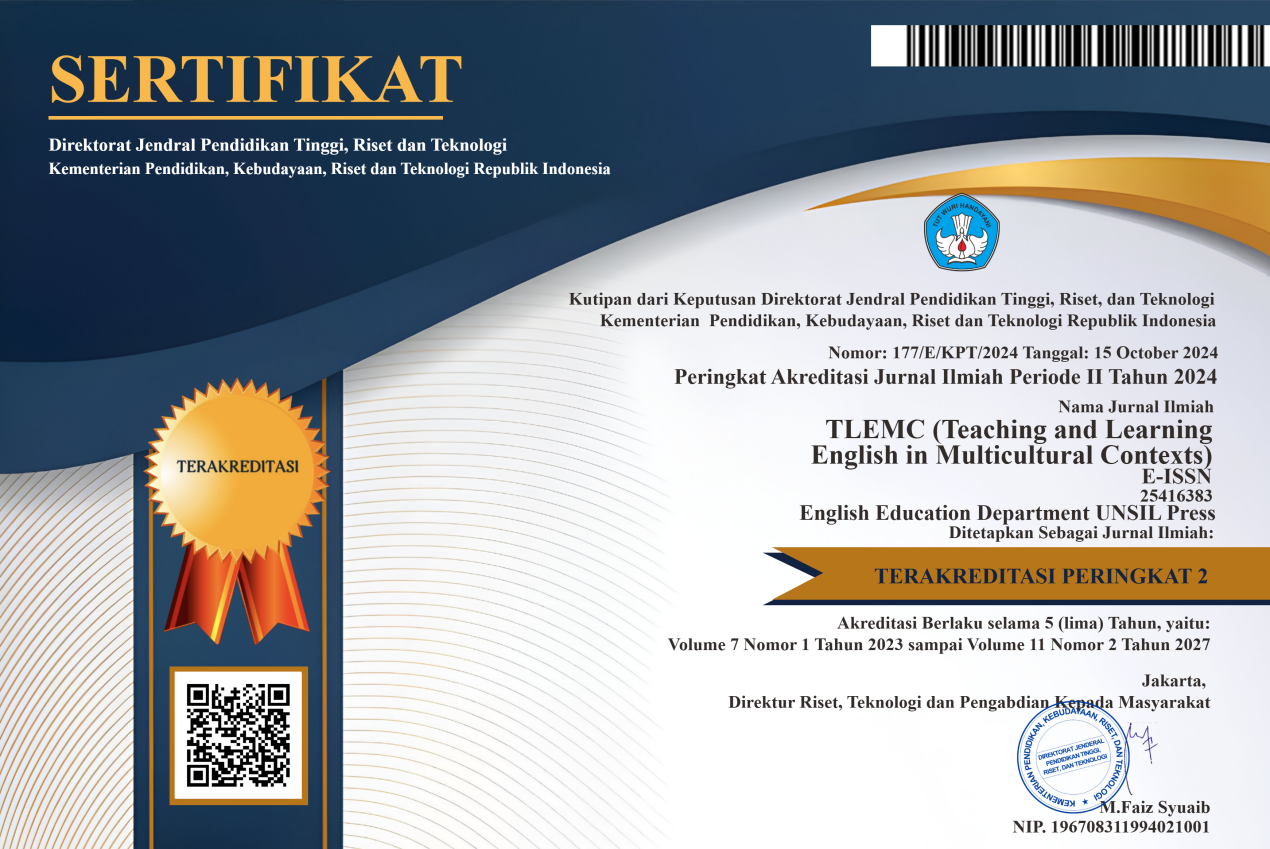An Analysis of Learners’ Oral Errors: A Study in One-to-one EFL Classroom Interaction
Abstract
Correcting the repeated errors produced by the learners is one of the most frustrating things to do by teachers. However, it is natural for the students to commit errors while learning since it can be a sign of improving language competence and as a facilitating factor in second language learning (Atmaca, 2016). This study aims to find out the types and frequency of learners’ oral error occurrence during the teaching and learning process in one-to-one EFL classroom interaction. This research applied descriptive qualitative research with case study design. Two adult learners, who had the same English proficiency level, were chosen as research participants through purposive sampling in Amsterdam Institute, an informal school applying tailor-made system in the teaching and learning process. The data were collected through observation during teaching and learning process, and analyzed based on data analysis procedures consisting of data reduction, data display, and conclusion drawing and verification. The results revealed that all types of errors proposed in this research appeared during the observation and data analysis. Grammatical error dominated the error type, and lexical error was the least error type produced by the learners. Unsolicited use of L1 is excluded from the discussion of the result finding since it is not a part of the error type studied (Lyster, 1998). Furthermore, another finding indicates that the error committed by the learners continuously appeared in the next meeting the researcher observed. Therefore, it is suggested that the teacher should provide more triggers as an attraction for the learners’ intention so that they can figure out more about their errors, and engage the learners to provide themselves self-correction or self-repair by prompting them.
Full Text:
PDFReferences
Ahmed Al-Tamari, E. (2019). Analyzing speaking errors made by EFL Saudi university students. Arab World English Journal, Special Issue: The Dynamics of EFL in Saudi Arabia, 56–69. https://doi.org/10.24093/awej/efl1.5
Alahmadi, Nesreen S. (2014). Errors analysis: A case study of Saudi learner’s English grammatical speaking errors. Arab World English Journal, 5(4), 84–98. Retrieved from https://www.academia.edu/download/62035064/Error_Analysis20200208-80914-fui6b1.pdf
Alahmadi, Nesreen Saud, & Kesseiri, R. (2013). Language transfer and grammatical speaking errors among Saudi students. Arab World English Journal, 4(3), 251–265. Retrieved from https://www.researchgate.net/profile/Nesreen_Alahmadi2/publication/338793470_Language_Transfer_and_Grammatical_Speaking_Errors_among_Saudi_Students/links/5e2addb2a6fdcc70a146e8e7/Language-Transfer-and-Grammatical-Speaking-Errors-among-Saudi-Students.pdf
Ander, S., & Yildirim, Ö. (2010). Lexical errors in elementary level EFL learners’ compositions. Procedia - Social and Behavioral Sciences, 2(2), 5299–5303. https://doi.org/10.1016/j.sbspro.2010.03.864
Atmaca, Ç. (2016). Error analysis of Turkish EFL learners: A case study. Procedia - Social and Behavioral Sciences, 232, 234–241. https://doi.org/10.1016/j.sbspro.2016.10.007
Birdsong, D., & Molis, M. (2001). On the evidence for maturational constraints in second-language acquisition. Journal of Memory and Language, 44(2), 235–249. https://doi.org/10.1006/jmla.2000.2750
Briceño, A., & Klein, A. F. (2018). Running records and first grade english learners: An analysis of language related errors. Reading Psychology, 39(4), 335–361. https://doi.org/10.1080/02702711.2018.1432514
Broth, M., & Lundell, F. F. (2013). Napouléon’s sequential heritage. Using a student error as a resource for learning and teaching pronunciation in the French foreign language classroom. Classroom Discourse, 4(1), 89–109. https://doi.org/10.1080/19463014.2013.783498
Brown, A. (1992). A survey of attitudes and teaching practices related to pronunciation teaching. AMES WA.
Brown, R. (1973). A first language. Harvard University Press.
Burgos, P., Cucchiarini, C., van Hout, R., & Strik, H. (2014). Phonology acquisition in Spanish learners of Dutch: Error patterns in pronunciation. Language Sciences, 41, 129–142. https://doi.org/10.1016/j.langsci.2013.08.015
Corder, S. P. (1967). The Significance of learner’s errors. International Review of Applied Linguistics in Language Teaching, 5(4), 161–170. https://doi.org/10.1515/iral.1967.5.1-4.161
di Gennaro, K. (2016). Searching for differences and discovering similarities: Why international and resident second-language learners’ grammatical errors cannot serve as a proxy for placement into writing courses. Assessing Writing, 29, 1–14. https://doi.org/10.1016/j.asw.2016.05.001
Eberhard, K. M. (1999). The cccessibility of conceptual mumber to the processes of subject-verb agreement in English. Journal of Memory and Language, 41(4), 560–578. https://doi.org/10.1006/jmla.1999.2662
Erdoğan, V. (2005). Contribution of error analysis to foreign language teaching. Mersin University Journal of the Faculty of Education, 1(2), 261–270. https://dergipark.org.tr/en/download/article-file/161018
Fareh, S. (2014). Macrolinguistic errors in Arab EFL learners’ essays. Procedia - Social and Behavioral Sciences, 141, 923–933. https://doi.org/10.1016/j.sbspro.2014.05.161
Farrokh, P. (2011). Analysing of EFL learners’ linguistics Errors: Evidence from Iranian translation trainees. Theory and Practice in Language Studies, 1(6), 676–680. https://doi.org/10.4304/tpls.1.6.676-680
Fraenkel, J., & Wallen, N. . (2008). How to Design and Evaluate Research in Education (7th Ed.). McGraw-Hill International Edition.
Fraser, H. (2000). Coordinating improvements in pronunciation teaching for adult learners of English as a second language. DETYA (ANTA Innovative Project). https://helenfraser.com.au/wp-content/uploads/ANTA-REPORT-FINAL.pdf
Gass, S., Bahney, J., & Plonsky, L. (2013). Second language acquisition: An introductory course (4th ed.). Routledge.
Hakuta, K. (1976). a Case Study of a Japanese Child Learning English As a Second Language. Language Learning, 26(2), 321–351. https://doi.org/10.1111/j.1467-1770.1976.tb00280.x
Hojati, A. (2013). An investigation of errors in the oral performance of advanced-level Iranian EFL students. Mediterranean Journal of Social Sciences, 4(4), 171–179. https://doi.org/10.5901/mjss.2013.v4n4p171
Kamil, D., Suhaimi, Hartono, R., & Vintoni, A. (2017). TEFL Students’ Language Learning Strategies: The Case of One State Islamic Institute in Indonesia. Ta’dib : Journal of Islamic Education, 22(2), 70–76. https://doi.org/10.19109/tjie.v22i2.1641
Lambani, M. N., & Nengome, Z. (2017). Selected common errors committed by third year university English students. International Journal of Educational Sciences, 18(1–3), 79–86. https://doi.org/10.1080/09751122.2017.1305758
Larsen-Freeman, D. E. (1975). The acquisition of grammatical morphemes by adult ESL students. TESOL Quarterly, 9(4), 409–419. https://doi.org/10.2307/3585625
Lasagabaster, D., & Sierra, J. M. (2005). Error correction: Students’ versus teachers’ perceptions. Language Awareness, 14(2–3), 112–127. https://doi.org/10.1080/09658410508668828
Lumban Batu, P. N. F., Puspitasari, L., Larsen, B., & Sitepu, V. T. (2018). Grammatical errors in students speaking English: An error analysis on Indonesian maritime students. Asian EFL Journal, 20(7), 89–93. Retrieved from https://www.researchgate.net/publication/332330314%0AGrammatical
Lyster, R. (1998). Negotiation of form, recasts, and explicit correction in relation to error types and learner repair in immersion classrooms. Language Learning, 48(2), 183–218. https://doi.org/10.1111/1467-9922.00039
Lyster, R., & Ranta, L. (1997). Corrective feedback and learner uptake: Negotiation of form in communicative classrooms. Studies in Second Language Acquisition, 19(1), 37–66. https://doi.org/10.1017/S0272263197001034
Mahmoodzadeh, M. (2012). A cross-linguistic study of prepositions in Persian and English: The effect of transfer. Theory and Practice in Language Studies, 2(4), 734–740. https://doi.org/10.4304/tpls.2.4.734-740
Miles, M., Huberman, M., & Saldana, J. (2014). Qualitative Data Analysis: A Method Sourcebook. Sage Publications.
Montrul, S. (2011). Morphological errors in Spanish second language learners and heritage speakers. Studies in Second Language Acquisition, 33(2), 163–192. https://doi.org/10.1017/S0272263110000720
Nagata, R., Takamura, H., & Neubig, G. (2017). Adaptive spelling error correction models for learner English. Procedia Computer Science, 112, 474–483. https://doi.org/10.1016/j.procs.2017.08.065
Ondrakova, J. (2016). The issue of errors in teaching foreign languages. Procedia - Social and Behavioral Sciences, 217, 101–108. https://doi.org/10.1016/j.sbspro.2016.02.037
Ramasari, M. (2017). Students’ pronounciation error made in speaking for general communication. Linguistics, English Education and Art (LEEA) Journal, 1(1), 37–48. https://doi.org/10.31539/leea.v1i1.32
Read, J., & Chapelle, C. A. (2001). A framework for second language vocabulary assessment. Language Testing, 18(1), 1–32. https://doi.org/10.1177/026553220101800101
Richards, J. C. (1971). A non-contrastive approach to error analysis. In J. C. Richards (Ed.), Error analysis: Perspective on second language acquisition (1st ed., pp. 172–191). Taylor & Francis.
Richards, J. C. (1973). Error analysis. Longman.
Richards, J. C., & Sampson, G. (1974). The study of learner English. In J. C. Richards (Ed.), Error analysis: Perspective on second language acquisition (13th ed., pp. 3–18). Longman.
Sampson, A. (2012). “Coded and uncoded error feedback: Effects on error frequencies in adult Colombian EFL learners’’ writing".†System, 40(4), 494–504. https://doi.org/10.1016/j.system.2012.10.001
Sari, R. A. (2018). Students’ grammatical error analysis in speaking. Edukasi: Jurnal Pendidikan dan Pengajaran, 5(2), 127–137. https://doi.org/10.19109/ejpp.v5i2.2102
Satake, Y. (2020). How error types affect the accuracy of L2 error correction with corpus use. Journal of Second Language Writing, 50, 100757. https://doi.org/10.1016/j.jslw.2020.100757
Strevens, P. (1969). Two ways of looking at error-analysis. ERIC, 1–10. Retrieved from https://eric.ed.gov/?id=ED037714
Tarawneh, R. T., & Almomani, I. M. (2013). The spoken errors and mistakes committed by senior English students at Princess Alia University College. Theory and Practice in Language Studies, 3(3), 497–502. https://doi.org/10.4304/tpls.3.3.497-502
Willing, K. (1978). Learning styles in adult migrant education. National Curriculum Centre.
Yates, L. (2001). Teaching pronunciation in the AMEP: Current practice and professional development. Macquarie University Press.
DOI: https://doi.org/10.37058/tlemc.v5i2.3937
Refbacks
- There are currently no refbacks.
INDEXED BY:
This work is licensed under a Creative Commons Attribution-NonCommercial-ShareAlike 4.0 International License.
![]()
TLEMC (Teaching and Learning English in Multicultural Contexts)
Program Studi Pendidikan Bahasa Inggris
Fakultas Keguruan dan Ilmu Pendidikan
Universitas Siliwangi
Jl. Siliwangi No. 24 Kota Tasikmalaya - 46115
email: tlemc@unsil.ac.id





